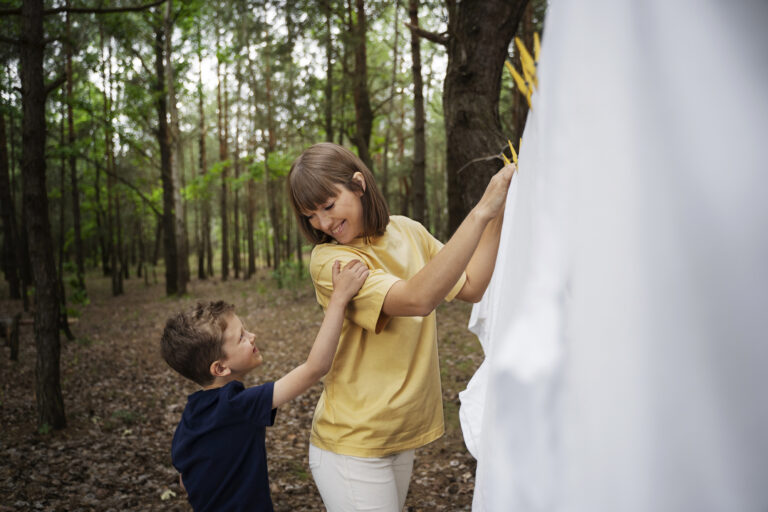Bathing a newborn is a special moment that strengthens the bond between parents and children and promotes the baby's hygiene and well-being. However, for many first-time parents, this task can seem challenging, especially in the first days of a baby's life.
Safety and comfort during bathing are fundamental, and small precautions make all the difference in making this moment peaceful and pleasurable. From the ideal water temperature to choosing products suitable for baby's delicate skin, every detail contributes to ensuring a safe and welcoming experience.
In this article, you will find a complete guide with practical guidelines for bathing a newborn safely. We will cover everything from preparing the environment and organizing the necessary items to step-by-step bathing and special care for the baby's sensitive skin!
Fundamental steps for safe bathing
Ensuring the baby's safety during bathing requires attention to every detail of this process, and before starting, it is essential to prepare the environment, keeping it warm and free from drafts. Furthermore, it is important that all necessary items, such as towels and hygiene products, are within easy reach to avoid absences.
Water temperature is a crucial factor, and ideally the water should be warm, between 36°C e 37°C. The bathtub should not be too full – about 5 to 7 centimeters of water – and never put the newborn in the water while it is still being adjusted to avoid burning them.
During the bath, the little one must be held firmly, supporting their head and neck with one hand while the other performs hygiene. Cleaning should start with the face, then the leather can be washed with a mild shampoo, and the body should be gently soaped with a soap suitable for babies.
After bathing, it should be carefully removed from the water and immediately wrapped in a soft towel. Drying should be done with light touches, without rubbing the skin. If the umbilical stump has not yet fallen off, it is important to dry it and, if recommended by your pediatrician, apply 70% alcohol to prevent infections.
Preparing for a baby's bath
Bathing a baby is a special moment that requires care, planning and attention to ensure comfort and safety. Before starting, it is essential to prepare the environment and gather all the necessary items, avoiding the need to move away during the shower.
To begin with, it is important to choose a place protected from drafts, with a pleasant temperature so that the baby does not feel cold. Position the bathtub on a stable surface and at the appropriate height, facilitating safe handling for the baby and avoiding discomfort for the parents.
Organize essential items within easy reach: soft towel, clean diaper, comfortable clothes, cotton wool, neutral liquid soap, baby shampoo and, if necessary, a soft-bristled brush. This prevents you from having to leave your baby unsupervised.
The water temperature must be between 36°C and 37°C. To do this, use a specific thermometer or test with the back of your hand or forearm – which are the regions most sensitive to heat. Avoid very cold or hot water to avoid discomfort or burns.
Before putting your baby in the bathtub, wash your hands well and position yourself safely. At this moment, hold the baby firmly, supporting the head and neck with one hand while the other gently performs the hygiene. This posture guarantees stability and security.
The ideal temperature and amount of water for bathing
The ideal temperature and amount of water for baby's bath are essential factors to ensure comfort and safety during this special moment. Starting with the water, it must be between 36°C and 37°C and must guarantee a pleasant sensation for the newborn.
To measure temperature accurately, using a bath thermometer is the safest option. If the water is too hot, add a little cold water and mix well before placing the baby in the bathtub.
The amount also needs to be adjusted carefully: the ideal level is 5 to 7 centimeters, covering only the lower part of the baby's body, without submerging the baby's face and head. Adding too much water can pose a risk of drowning, while too little water can make it difficult to maintain body temperature.
Before starting the bath, make sure to mix the water well to ensure a uniform temperature throughout the bathtub. Avoid pouring water directly on the baby without testing it first, as the temperature can vary at different points, especially if the water has been mixed recently.
Furthermore, it is essential to prepare the environment to avoid thermal shocks when removing the baby from the water. Keep the bathroom or bedroom warm, with a temperature between 24°C and 26°C, reducing the risk of getting cold after taking a shower.
Recommended baby skin care products
The delicate skin of newborns requires special care to avoid irritation and allergies. Choosing the right products is essential to ensure hygiene and protection of your baby's sensitive skin.
Soaps and hygiene products
The ideal is to use neutral and mild liquid soaps, specially formulated for babies. Choose hypoallergenic versions, without dyes, alcohol or artificial fragrances, which minimize the risk of allergies and dryness.
Baby skin hydration
Hydration is essential, especially in cold regions or when the skin shows signs of dryness. Baby-specific moisturizing lotions or creams, with ingredients such as glycerin, almond oil or shea butter, offer deep hydration without clogging pores.
Children's oils and massages
Baby oil is a great ally for relaxing massages and for gently removing residue on the skin, such as cradle cap on the scalp. Choose oils based on calendula, chamomile or aloe vera, which have calming and moisturizing properties.
Diaper and wipe care
Choose high-absorbency disposable diapers to keep your baby's skin dry and prevent diaper rash. Baby wipes should be alcohol- and perfume-free, with gentle formulas that contain calming ingredients such as aloe vera and chamomile.
Conclusion
Bathing the newborn is a special moment that goes beyond hygiene care, providing a unique emotional bond between parents and baby. However, for this experience to be safe and pleasurable, it is essential to follow important recommendations and ensure certain care for the baby's sensitive skin.
By establishing a safe and calm bathing routine, parents gain confidence in handling their baby, transforming bathing into a moment of relaxation and affection. Maintaining a firm and safe posture when holding it, avoiding the use of aggressive products and maintaining constant attention throughout the process are fundamental measures.
With adequate preparation and the correct choice of products, your newborn's bath becomes a special moment of affection and connection. Over time, this routine becomes increasingly natural and pleasurable, contributing to the baby's well-being and healthy development, in addition to strengthening family ties in a unique way.




